My second berried Blue Jelly Shrimp has just hatched her eggs two days before I was expecting them. She has only been berried for 22 days, that is two days less than my first Blue Jelly. She was hiding inside the coconut cave, it seems to be the favoured place for my Berried Shrimps to hang out and they have not only passed their eggs down from their saddle to their Pleopods inside there, and spent a lot of time in there whilst berried, but they also seem to retreat back inside when it is hatching time.
I have managed to spot three tiny little shrimplets from this new batch, and I am surprised at the size difference between them and my first batch of shrimplets. I had not realised how much they had grown. It is not so much the length that has changed, it is more that the older ones seem to have bulked out and look more stocky in build, though I think they are also a little longer.
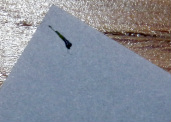
The first thing I noticed was a tiny thing floating at the top of the tank. I managed to fish it out and put in onto a piece of paper. Looking under a microscope (yes, I really am that obsessive), I could see that it was a larval looking shrimp, it had teh overall body shape, but no legs. AT first I assumed that it was a Ninja Shrimps shrimplet as they cannot survive in freshwater. I then noticed my Blue Jelly was just inside the cave and was looking paler than she had been looking earlier. That was when I saw two tiny Blue Jelly Shrimplets sitting just outside the Coconut cave and realised that what I had fished out must have been a Blue Jelly Shrimplet that had not fully developed for whatever reason.
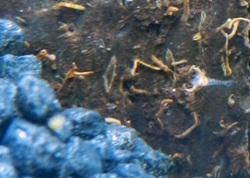 Out of focus but you can just about make out the small shape on the side of the coconut in the middle on the right hand side.
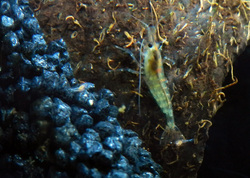 Under the tail of this male Blue Jelly is one of the newly hatched shrimplets. You can see just how tiny they are in comparison.
| 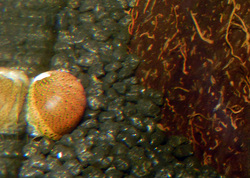 Again, this image is not very clear but there is a tiny shrimplet on the side of the coconut and a second one can just be made out next to the Candy Nerite Snail.
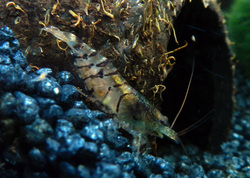 Again, there is a tiny Blue Jelly Shrimplet underneath the Tiger shrimps tail, giving a good idea of the scale of how tiny these newly hatched babies are.
| 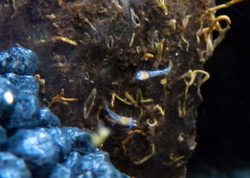 Although this image is still blurred you can make out two tiny Blue Jelly shrimplets on the side of the coconut cave. This is the best I can do as they are so tiny (2-3mm long).
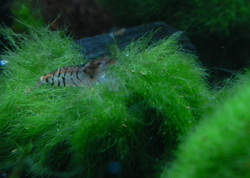 In contrast (though sadly still out of focus) you can see in the foreground an adult male Tiger shrimp, and on the black charcoal tunnel you can see an older Blue Jelly shrimplet and how much larger it looks
|







 RSS Feed
RSS Feed